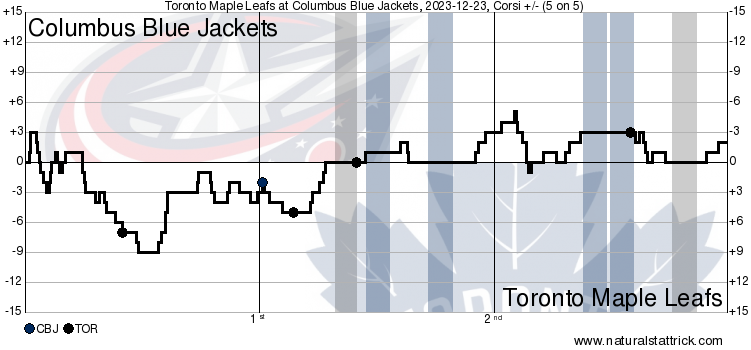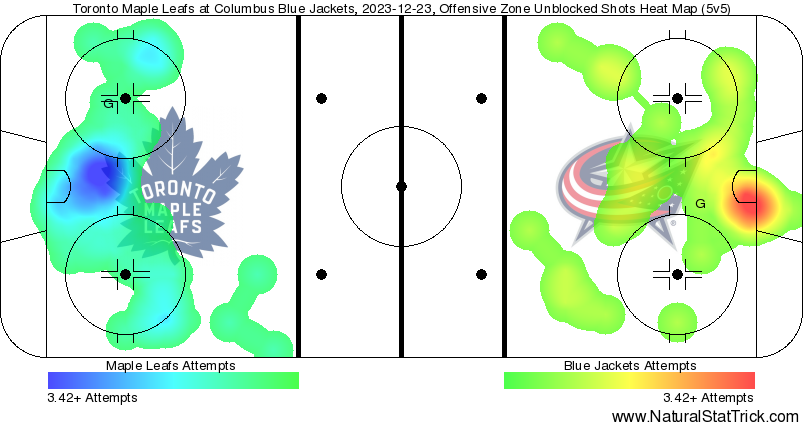Martin Jones provided some much-needed stability in net and the Core Four scored all four Toronto goals across four different game states — one on the power play, one at five-on-five, one at four-on-four, and one shorthanded — as the Maple Leafs got the response they needed in Columbus before the Christmas break.
Your game in 10:
1. As we saw in their 6-5 thriller a few weeks ago, this is a meeting between two high-event teams — at five-on-five, both entered the game in the top 10 in both shot attempts for and against per 60 as well as goals for and against per 60.
The first period lived up to the billing. It was 1-0 period in favour of Toronto, but there were 30 shots on goal split 16-14 in favour of Columbus, and both goaltenders were sharp to keep it at just one goal.
The reunited top-line pairing of Auston Matthews – Mitch Marner was Toronto’s most dangerous presence by far with eight on-ice shot attempts, six shots on goal, and the 1-0 goal in the first period. They were both working to win pucks back defensively and on the forecheck (Matthews made a few key defensive plays in his own zone in the first period, one of which may have saved a goal just before he scored at the other end). They also had one sketchy shift including a couple of turnovers by Matthews and Knies leading to scoring chances for Columbus, but they were a constant threat offensively.
Columbus was hurrying the Leafs into too many turnovers on the breakout in the first period, but Martin Jones was really solid in making all 16 saves asked of him. What a massive difference reliable goaltending makes.
2. It felt inevitable the top line was going to break through early in this game. Sure enough, the Leafs took the lead five minutes into the first period on a play that started with a turnover following good forechecking pressure from Matthew Knies and Mitch Marner, who pounced on a defensive-zone turnover by Columbus.
Occasionally, it can be frustrating when Marner looks to extend plays instead of shooting — seeking out the A+ scoring chance instead of taking the A chance in front of him — but his creative genius and patience with the puck were rewarded here. With a clear look at goal, he held onto the puck, rounded the net, and then picked out Matthews opening up for the one-timer. Matthews buried it with the confidence of a player on pace for 70+ goals.
🎵 It's the magic of… Mitch Marner 🎵 pic.twitter.com/0QS2mfaafq
— Toronto Maple Leafs (@MapleLeafs) December 24, 2023
3. On Friday, Sheldon Keefe lamented how “it was a highway to our net” in the Buffalo game. Conceding easy goals has been a major theme for the Leafs during their recent defensive downturn.
The 1-1 Blue Jackets goal just seconds into the middle frame was more of the same — it came on a free-and-clear breakaway off of a simple give-and-go by Columbus through the neutral zone, with Jake McCabe caught up ice. McCabe was gambling on keeping the puck in along the wall as it was chipped off the glass, but it took a strange bounce in Columbus’ favour, leaving McCabe stranded.
The Leafs gave up another breakaway just a couple of minutes later during a spell of four-on-four action after offsetting diving and hooking calls to Adam Fantilli and David Kampf, respectively. At four-on-four, Morgan Rielly jumped up for a rush led by William Nylander, and after Nylander turned it over at the line, John Tavares was caught unaware of Justin Danforth slipping in behind him. Danforth either fired wide or Jones got a slight piece of it with his blocker, but either way, this turned out to be a major swing point in the game.
4. Seconds later, still at four-on-four, John Tavares scored on a beautiful solo effort. Spinning off the wall in between three Blue Jackets defenders, he opened up a pocket of space for himself and ripped it top shelf. It’s remarkable how much power Tavares can put behind a shot when he leans into a quick no-windup snapper like this:
SON OF A NUTCRACKER! WHAT A GOAL! 😳 pic.twitter.com/kpgM8Uee5F
— Toronto Maple Leafs (@MapleLeafs) December 24, 2023
Two elite plays by the Leafs’ elite talent put them up 2-1.
5. Speaking of power, five minutes later, Auston Matthews scored his second one-timer of the game — again assisted by Mitch Marner — on the power play after drawing the initial penalty.
On the MLHS podcast this week, former Leafs assistant coach Andrew Brewer shared an interesting anecdote about Matthews’ lack of comfort playing his one-timer side on the power play when he first broke into the league; he didn’t feel confident enough in his one-timer to play on the right, which was the reason why Marner and Matthews (controversially among the fans and media) were often on their strong sides on the flanks. Matthews went away and greatly improved his one-timer in a single summer spent working with skills coach Darryl Belfry, and we saw the fruits of that labour on both goals tonight (among the many examples over the past few years).
The drive to continuously add layers to an already extremely gifted goal-scoring repertoire is why Matthews is sitting with 28 goals through 30 games, the best goal-scoring start since Jaromir Jagr and Mario Lemieux in the mid-90s. Special stuff.
6. After the Fantilli off-setting diving call and a non-call just before the Leafs’ 3-1 power-play goal, you could sense the even-up calls coming from the officials, and they arrived in the form of four Leaf penalties between roughly the midway points of the second and third periods. That created a lot of PK time for the Leafs in a 20-ish minute span.
One call was automatic — a Tyler Bertuzzi flip-out into the crowd — and one was silly (Max Domi dropped his stick and it bounced up into the face of Cole Sillinger), but two others were bad offensive-zone penalties by the fourth line (Bobby McMann and Noah Gregor). Against good teams with effective power plays, four opportunities are most often a ticket back into the game.
7. The Leafs’ PK was so effective over those eight minutes of kill time that it really took the wind out of Columbus’ sails down two goals. Part of it was the Blue Jackets’ continued incompetence up a man, but the Leafs PK certainly played its role, disrupting effectively up the ice in the neutral zone, denying the line, or isolating puck carriers for a quick recovery + clearance when Columbus broke into the zone. Mitch Marner was particularly dialed in while shorthanded, hurrying the Blue Jackets’ decisions, jumping plays, and clearing pucks down the ice.
With Auston Matthews and William Nylander out on the ice killing a penalty midway through the third, Matthews made a few nice plays — one to break up a pass and clear the zone with a sweep of his stick, and then another to disrupt an entry by Columbus. The efforts led by the star talent shorthanded culminated in a put-away goal late in the kill by Nylander, who scored his second shorthanded goal of the season and registered his third shorthanded point.
After Jake McCabe and Matthews combined to send Nylander and TJ Brodie away on a 2v1 rush, Nylander wisely used Brodie as a decoy and patiently waited until Daniil Tarasov went down before roofing his 16th of the season.
WILLY, YA FILTHY ANIMAL!!! pic.twitter.com/aQfLgKuKld
— Toronto Maple Leafs (@MapleLeafs) December 24, 2023
In 10:25 of shared ice time on the PK so far this season, Nylander and Matthews have out-shot the opposition 7-4 and out-scored them 1-0.
8. It appeared as though the successful PKs (x4) not only significantly hurt Columbus’ morale but also translated over onto five-on-five for the Leafs in terms of locking down the neutral zone more tightly and slowing down a fast Blue Jackets team after a fairly chancy first 25 or so minutes of the game. The stabilizing goaltending performance by Martin Jones — particularly his work early in the game — has a notable calming effect on the team’s defense, and the Leafs managed the game fairly well in front of him once they held the multi-goal lead.
After Toronto gave up six high-danger chances in the first period alone (followed by the breakaway goal at the start of the second), the Blue Jackets were credited with just one high-danger chance at five-on-five in the final 40 minutes — including zero in the third period — according to Natural Stat Trick. The Leafs simplified effectively on the breakout, flipping pucks out when necessary. They didn’t retreat into a defensive shell — even drawing a power play to help kill the game off — and salted the game away without too much stress.
At five-on-five, Toronto actually edged the shot attempts in the third period and controlled the shot, xGF, and scoring chance share by a significant margin despite leading by multiple goals.
9. Mitch Marner played nearly 22 minutes partly due to all the special teams time and finished with two assists (one at five-on-five, one on the power play), four shots on goal, and over a 60% xGF share at five-on-five. Auston Matthews started the game with tons of jump offensively and commitment defensively, scoring the first two goals before playing a significant role in the build-up to William Nylander’s shorthanded tally to ice the game at 4-1.
Good teams should never lose to a bottom-feeder like Columbus twice in the span of a few weeks, and the Leafs needed their leaders to lead the way after a 9-3 embarrassment at the hands of Buffalo. The core stepped up to calm the waters entering the holiday break.
10. Last but not least: A safe and happy holiday to all of our readers at MLHS. We’re eternally grateful for your continued readership and support.






































